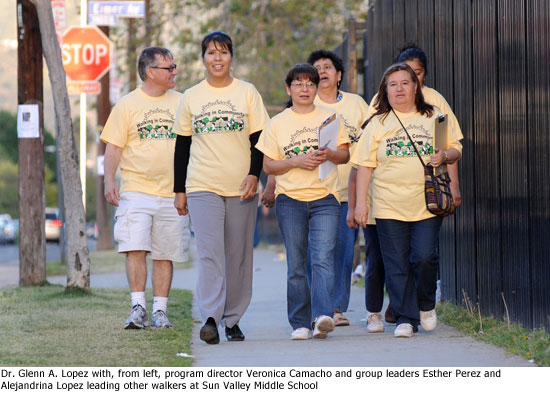A big step for Valley walkers
May 7, 2010
The walking doc’s back. And in case you missed him the first time around the block, here are a couple of things he won’t be bringing with him: a pedometer and a drill master’s go-for-the-burn attitude.
In fact, Dr. Glenn A. Lopez, creator of the Walking in Community program now up and running in Sun Valley and Sylmar, thinks the “community” piece of the equation is just important as the exercise itself when it comes to building healthy habits that last.
Lopez is an assistant professor in UCLA’s Department of Family Medicine and president of OnSite Health Solutions, a mobile medical clinic serving uninsured and chronically ill patients. At a press conference Monday, officials from the Health Net Foundation are expected to announce a $200,000 grant to his company to expand his mobile medical care to, eventually, 18 San Fernando Valley locations. Providence Health & Services previously contributed to, and currently contracts with, Lopez as well.
Lopez’s community-based approach to medicine is at the heart of his free walking program. And to get that effort off on the right foot, Lopez started by simply listening.
Before the initial launch of Walking in Community in 2006, he interviewed 200 families to learn more about their interests and attitudes.
“We got some very surprising results,” he says. “Eighty-three percent were very interested in walking with their neighbors around the block if somebody else set it up. It was about getting to know your neighbors.”
For women, that ranked as the No. 2 reason for starting a walking regimen, right behind “health and losing weight.” For men, it was reason No. 1.
Throw in a little motivation in the form of a free yellow T-shirt for people who’ve walked six times, and you’ve got a runaway—make that walkaway—success.
Eventually, more than 3,000 people took part—40% of them children.
“We had whole families walking together,” Lopez says. “These walking groups became like a community…And we found that if people walked for two weeks, they had a 75% chance of still walking three months later.”
Funding for the original effort ran out in 2008, but now the program is back, underwritten with two $25,000 grants—one from the county, on a motion by Supervisor Zev Yaroslavsky, and the other from Los Angeles City Councilman Tony Cardenas.
Groups currently are walking three times a week at three San Fernando Valley sites: Sun Valley High School, Sun Valley Middle School and Sylmar High School.
“It’s great,” says Carmen Holguin, 42, who was among those promenading around Sun Valley Middle School on a recent evening. “You move, you feel good, the stress is less. Your weight is less, too.”
Family groups are out in force. One extended group includes a 5-year-old on a scooter, her mother, three aunts and her 69-year-old grandmother.
No one, it seems, is walking alone. “They know each other, and it’s safe here,” says one of the leaders, Alejandrina Lopez, who was there with her daughter, Stephanie, a 6th grader.
“A lot of [original participants] are coming back,” says Veronica Camacho, the program’s director. “They were begging us to come back.”
Lopez says the idea for the walking groups grew out of his earlier studies of programs to combat asthma, childhood obesity and diabetes—a disease that is prevalent but often untreated among many in his predominantly Latino clientele.
Lopez, who received his medical degree from Cornell and did his residency at Cook County Hospital in Chicago, also worked for 10 years in rural Guatemala, administering medical care to workers on coffee and banana plantations from the back of his pickup truck and eventually building a network of 94 work-site clinics. As poor as his patients there were, he says, they “had the most important thing”—a sense of connection.
Lopez, 53, who lives in Northridge with his wife and two children, says he thinks his communal exercise program can help combat social isolation that leads to depression, a common problem among those he serves here in Los Angeles.
“Isn’t it ironic and isn’t it fantastic,” Lopez says, “that our marginalized communities are showing a way to come together and support each other?”
He also believes that small steps can be incredibly powerful.
“If I had to rate what is the most important thing about the walking, it is to welcome people, to be congenial and tolerant. This is a way of breaking the isolation that people are living in.”
And as for fancy hi-tech equipment? You can leave that at home.
“I’m against the use of pedometers,” he says. “If you’re 150 pounds overweight, OK, you’ve got to do 10,000 steps. They do 100 and already their heart is racing. They give up.”
But remember the yellow shirt.
“People want their T-shirts,” Lopez says. “They want that sense of doing something bigger, being a part of something.”
Posted 5-07-10














 405 bridge work causes a stink
405 bridge work causes a stink
